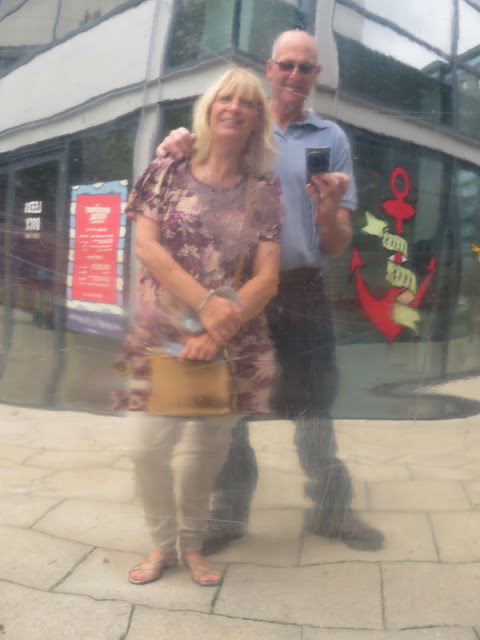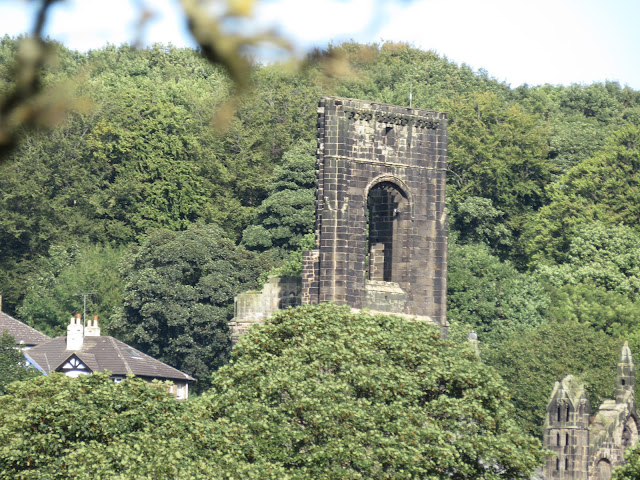When we left we didn't have far to go to the first lock of the day, Hirst Lock. One boat had passed and we thought we wouldn't have too long to wait for another boat to come along to share with us.
We were right and before we had opened the gates of the lock a boat had rolled up and we shared the rest of the locks of the day with 'Old Friends, Bookends', and lo and behold he was from Beverley and they had a house in Hull and a daughter at University there. That is them ahead of us just after the lock.
You cross over the River Aire a bit further on. There are plenty of trees that hide the river but it isn't quite what it will be by the time it gets to Castleford.
Having travelled up the Dowley Gap 2 Rise the chimney of the Damart Mill announce that we are now at the Bingley 3 Rise flight. I love the mill buildings and the detail that would have cost hard earned money but the owners still smartened up the exterior to gladden the heart for generations coming.
The 3 Rise lift the canal 30 feet and were opened in 1774. By the time they had survived until 1985 they became Grade II Listed. There was a very cheerful lock keeper to help so the girls were happy.
Thence to the Bingley 5 Rise that was also opened in 1774. It is a shame that there is now 4 Rise as then there would be a full set from 1 to 5 lock flights! The gradient is 1:5 and the lock gates in the middle are the tallest on the system. The 5 rise is Grade I listed. The first boat to use the lock took just 28 mins. I'm not sure how long it took us, but less than 40 mins I'm sure.
We had to be very careful when getting in the lock as 'Good Friends' and 'Holderness' are long and some of the gates are leaking very badly. Some were like hose pipes so it was a matter of only getting the bow in harms way of the water until the lower gates are closed and we can move astern.
The view from the top is quite amazing as the 60 foot rise in just 320 distance is a steep hill to climb. As it was a Bank Holiday weekend there were many gongoozlers out taking photos and asking questions, but the girls coped well, along with the lock keepers. I was asked for my Reg. number and I think that is the first time for ages our number has been put in the system. I hope I don't get a letter from C&RT.
We squeezed in astern of a boat moored up on the services and right in front of the tables of the cafe. Luckily we don't have to empty cassettes etc otherwise I reckon. they would have been put off their lunches. The water didn't take long and we were soon off from the top of the locks, with a good lock free run to look forward to, but 5 bridges to operate!
We carried on as we thought we would go and visit the National Trust property at East Riddlesden. The Hall was built for a clothier, James Murgatroyd in 1642 and is now Grade I listed. It is a very short work from the wharf mooring by bridge 197A.
This is the southern face of the Hall and it has a great view of the Aire Valley. Later in the life of the Hall it was rented out and the building converted to several 'flats'.
At the bottom of the 'garden', all that is left of around 2000 acres that went with the house, the River Aire bends around the small plateau that the house is built on.
The rear of the building shows the original house with it's Yorkshire Rose window, then what is called the Great Hall in the middle and the north facade of the Starkie wing that was built by the family of that name around the 17th Century. They lived there for around 100 years before the buildings were rented out as several homes. The Starkie wing was knocked down in 1905, except the front that remains, and the whole building was for sale. A builder bought it with the idea of knocking it down and building new houses on it. Mean time they sold off many of the fixtures and fittings. Until along came along the Brigg brothers William and John, one a Mayor of Keighley, bought it from them to save it. They also re purchased many of the fixtures that had been sold. In 1934 they gave the lot to the National Trust.
The rose windows are front and back and they are certainly a feature of the house both from outside and inside. Helen wants one now. The stone from the building is from Ilkley Moor and has blackened over the years. I don't think it would look as imposing if it was 'stone' coloured.
I was really pleased that we had been able to see the house as we had passed it a few times and it had a really homely feel about it despite it being all stone built and the volunteers telling is in winter it was often warmer outside sometime than in time.
























































